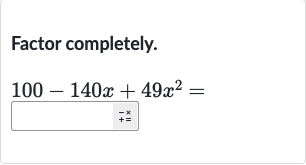AI tutor
Full solution
Q. Factor completely.
- Identify Coefficients: Step Title: Identify the CoefficientsConcise Step Description: Identify the coefficients of the quadratic equation, which are the numbers in front of the variables. In this case, the coefficients are , , and .Step Calculation: Coefficients are , , Step Output: Coefficients: , ,
- Rearrange Standard Form: Step Title: Rearrange in Standard FormConcise Step Description: Rearrange the quadratic equation in standard form, which is .Step Calculation: The standard form is .Step Output: Standard Form:
- Factor Greatest Common Factor: Step Title: Factor the Greatest Common Factor (GCF) Concise Step Description: Factor out the greatest common factor from the coefficients. Step Calculation: The GCF of , , and is . Step Output: Since the GCF is , we cannot factor anything out.
- Find Factors: Step Title: Find the FactorsConcise Step Description: Find two numbers that multiply to the product of the first and last coefficients and add to the middle coefficient .Step Calculation: Factors of that add up to are and .Step Output: Factors: ,
- Write Factored Form: Step Title: Write the Factored FormConcise Step Description: Write the factored form of the quadratic equation using the factors found in the previous step.Step Calculation: The factored form is , since gives .Step Output: Factored Form:
More problems from Factor polynomials
QuestionGet tutor help
QuestionGet tutor help

